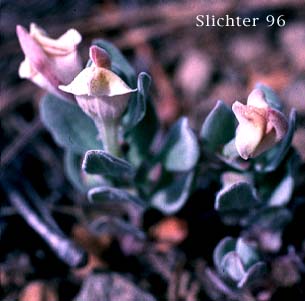 The photo at right shows the
narrow tube and broad head of the flowers of dwarf skullcap. Note the strongly
reflexed lower lip, closed throat, and arched upper lip. Photographed from Little
Crater, Newberry Crater National Volcanic Monument..........July 1, 1995.
The photo at right shows the
narrow tube and broad head of the flowers of dwarf skullcap. Note the strongly
reflexed lower lip, closed throat, and arched upper lip. Photographed from Little
Crater, Newberry Crater National Volcanic Monument..........July 1, 1995.
Dwarf skullcap is a perennial wildflower forming low mats on the ground. Several branches arise near the ground 5-10 cm high from tuberiferous rhizomes. The herbage of both the stems and leaves consists of ash-colored which are either fine and short or longer, stiff and appressed to the plant. Those of the leaves are more loosely spreading while those of the stems and calyx are closely deflexed or downcurved. The grayish leaves are opposite and closely spaced on the stems. The lower leaves are often ovate to diamond shaped with petioles several millimeters long. They range from 1-2 cm long and 3-7 mm wide. The upper leaves are oblanceolate to narrowly elliptic in shape with very short petioles and entire margins.
The flowers are solitary in the leaf axils, although they may appear paired since one flower arises from each of opposite leaf axils. The calyx is 3.5-5 mm long. The corolla is 14-21 mm long and a pale cream color with the lower lip also cream in color while the upper lip is typically a pale purple color. The base of the corolla tube is narrow, expanding near the middle to the broad mouth of the flower. The lower lip is strongly reflexed downward while the upper lip is arched. The throat of the corolla is nearly closed.
Dwarf skullcap is found in open, dry, barren ground, and is often found in conjunction with andesite or basalt or on sandy ground. It may be found from the lowlands up to near 2200 meters in the mountains.
Dwarf skullcap is found from Jefferson County, Oregon east to Gem County, Idaho, south to northern California and central Nevada.